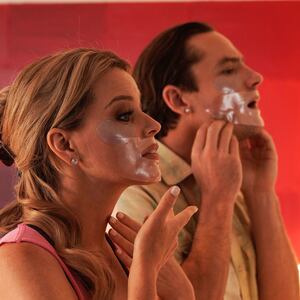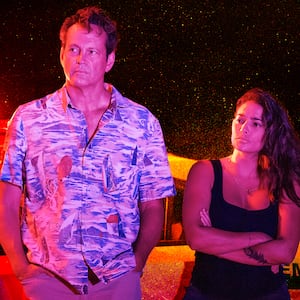Incarceration doesn’t just isolate and punish an individual. It rips people out of society and away from families, often leaving an absence as noticeable and painful as a wound.
The new Netflix-distributed documentary Daughters sounds like a sweet human-interest story about a father-daughter dance organized for prison inmates who don’t get much time with their children—and it is that, for a few fleeting moments. But much of it is a painful reminder of what’s lost in the shuffle of extended prison sentences.
The movie is loosely structured around an impending gathering grown out of an experiment begun in the Richmond, Virginia, area through Camp Diva, a program founded by Angela Patton (who is also credited as director of Daughters, alongside Natalie Rae). The idea is to bring the young daughters of inmates into a facility for a father-daughter dance, offering a chance for them to reconnect.
This is especially precious in an environment that often, as the doc explains, forces fathers to settle for expensive video calls or Plexiglass partitions in place of genuine person-to-person visits. (And that’s if the children are allowed to pursue visits at all; some of the mothers on the outside understandably blanch at the idea.) We meet four girls, all Black, ranging from kindergarten to teenhood, and their fathers, the latter mostly seen in mandatory parent training run by life coach Chad Morris, in the weeks leading up to the event.
Patton and Rae don’t shy away from mixed emotions or genuine discomfort, especially on the girls’ side.

A still from Daughters
NetflixSantana, first seen at 10, is angry with her dad Mark, having assumed a more parental role among her family in his absence, while Ja’Ana, first seen at 11, doesn’t have an instant rapport with Frank, whose face she can barely remember. That’s the unspoken fate that could await Aubrey, first shown at 5 and the youngest participant, bright-eyed and sharp. For the moment, she remembers her father Keith more clearly than the rest—he’s only gone away recently—and counts the time until he’ll come home. She knows it will be at least seven years. (His crime remains unspecified in the film, but by context it’s clear that it’s more serious than some of the other men the movie observes.)
The extended sequence at the dance, which arrives late in the movie but not as its finale, isn’t goosed with false drama. Patton and Rae capture some almost unbearably moving reunions—every tender moment between Aubrey and Keith is a heartbreaker—but find room for the awkward silences, unanswered questions, and fleeting nature of a one-off communion.

A still from Daughters
NetflixThere are sweet shots of the men getting dressed up in suits, ties, and fancy shoes, as well as shots of the clothing discarded into regulated piles at the end of the evening so they can change back into orange jumpsuits. Shooting on what looks like celluloid makes the footage seem all the more like home movies, a distillation of the various school events, family weddings, graduation parties, and so on that the fathers will, it’s implied, miss as they finish out their sentences.
The movie is less successful at conveying what, exactly, the fathers are learning in their sessions with Morris. (The ticking-clock chyrons—“five weeks until the dance”—aren’t enough.)
The classes obviously help them relieve some psychological burden, giving them an outlet to talk about their feelings as fathers, but the prisoners often come across as more practically-minded than their counselor, who stresses that they need to be there for their children without directly addressing many of the logistical challenges that stand in the way of this directive.

A still from Daughters
NetflixThis could just be a problem with the footage chosen; in a movie that creates longing to see more of these families and their stories, it juts out awkwardly to include a moment where an inmate essentially asks for a history of the Date with Dad program, and the movie cuts to Patton (co-director of the film, but not described that way in the moment) explaining it.
These choices don’t linger, however, as the film moves forward past the dance. Suddenly Aubrey, whose ebullient presence opens the movie with a 5-year-old’s chatterbox sweetness, is 7, then 8. It’s a 7 Up or Boyhood effect, as the audience realizes they’ve seen her age suddenly and irrevocably, and that Keith has barely seen more of her than we have. Patton may be directing a movie based on her own program—and the recidivism statistic the movie cites at the end hint at a stunning success—but she seems unafraid to show its limitations. One of them is a limit we’re all facing, here grown more fearsome and destructive: time.









